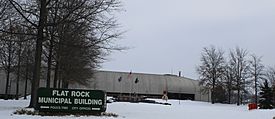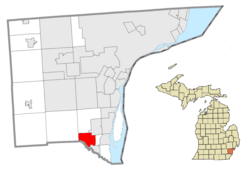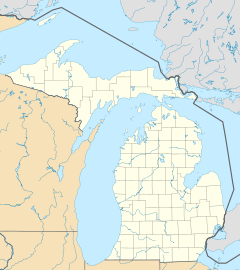Flat Rock, Michigan facts for kids
Quick facts for kids
Flat Rock, Michigan
|
||
|---|---|---|

Flat Rock Municipal Building
|
||
|
||

Location within Wayne County and the state of Michigan
|
||
| Country | United States | |
| State | Michigan | |
| Counties | Wayne; Monroe | |
| Incorporated | 1923 (village) 1965 (city) |
|
| Government | ||
| • Type | Mayor–council | |
| Area | ||
| • Total | 6.71 sq mi (17.37 km2) | |
| • Land | 6.57 sq mi (17.01 km2) | |
| • Water | 0.14 sq mi (0.36 km2) | |
| Elevation | 597 ft (182 m) | |
| Population
(2020)
|
||
| • Total | 10,541 | |
| • Density | 1,604.90/sq mi (619.61/km2) | |
| Time zone | UTC−5 (EST) | |
| • Summer (DST) | UTC−4 (EDT) | |
| ZIP Code |
48134
48173 (Rockwood) |
|
| Area code(s) | 734 | |
| FIPS code | 26-28360 | |
| GNIS feature ID | 0626146 | |
Flat Rock is a city located in the state of Michigan, United States. Most of the city is in Wayne County, Michigan, but a small part reaches into Monroe County, Michigan. In 2020, about 10,541 people lived there.
Contents
History of Flat Rock
Flat Rock started as a settlement for the Wyandot people, an Indigenous group. It was even set aside as a special area for them in the early 1800s.
Early European Settlers
The first European-American settlers arrived in Flat Rock between 1811 and 1820. Michael Vreeland and his five grown sons bought a large area of land. For a while, the town was known as the "Village of Vreeland." The Vreeland family built the first mills for grinding grain and cutting lumber. Today, some of Michael Vreeland's descendants still live in Flat Rock.
A French priest named Father Jean Dilhet mentioned a settlement called "Grosse Roche" in 1798. This name referred to a large limestone rock formation near the Huron River.
In 1818, land became available for purchase in Detroit. Soloman Sibley bought land that was later sold to Michael and Jacob Vreeland. At this time, there were also Native American villages nearby.
Growth and Development
When the Erie Canal opened in 1825, many people moved to Michigan, especially from New York. By 1828, Flat Rock had grown to include stores, sawmills, and a flour mill. It became a central place for local farmers.
The village of Flat Rock was officially planned and recorded in 1838. This happened because a company tried to build a canal connecting Lake Erie to Lake Michigan. However, this canal project was not successful.
Later, Henry Ford was interested in using the power of the Huron River. In 1925, he built the Ford Motor Company Lamp Factory there. The Flat Rock Dam was built to provide electricity for the factory.
Flat Rock officially became a village in 1923. It then became a city in 1965.
Geography of Flat Rock
Flat Rock is mainly in southern Wayne County. A small part of the city is in Monroe County, Michigan. This is because the border follows the Huron River's path from 1923.
Location and Roads
Flat Rock is surrounded by other towns. Woodhaven is to the northeast, and Rockwood is to the southeast. South Rockwood is across the Huron River in Monroe County.
U.S. Route 24 (Telegraph Road) goes through the middle of Flat Rock. This road leads north to Dearborn and southwest to Monroe. Interstate 75 is on the eastern side of Flat Rock. It provides easy access to Detroit to the northeast and Toledo, Ohio to the southwest.
Area and Water
The city of Flat Rock covers about 6.71 square miles (17.37 square kilometers). Most of this area is land, with a small portion being water.
Weather and Tornadoes
Flat Rock has a higher chance of tornadoes than the rest of Michigan and the United States. Two very strong tornadoes, called F4 tornadoes, hit Flat Rock in 1956 and 1965. The 1965 tornado caused 23 deaths and over 300 injuries.
Economy in Flat Rock
In December 2019, Flat Rock had an unemployment rate of 6.5%. This was a bit higher than the average for the United States. The average income per person was $27,549. The average income for a household was $63,375, which was higher than the U.S. average.
Population Information
Flat Rock has grown steadily over the years.
| Historical population | |||
|---|---|---|---|
| Census | Pop. | %± | |
| 1880 | 373 | — | |
| 1930 | 1,231 | — | |
| 1940 | 1,467 | 19.2% | |
| 1950 | 1,931 | 31.6% | |
| 1960 | 4,696 | 143.2% | |
| 1970 | 5,643 | 20.2% | |
| 1980 | 6,853 | 21.4% | |
| 1990 | 7,290 | 6.4% | |
| 2000 | 8,488 | 16.4% | |
| 2010 | 9,878 | 16.4% | |
| 2020 | 10,541 | 6.7% | |
| U.S. Decennial Census | |||
Population in 2010
In 2010, there were 9,878 people living in Flat Rock. There were 3,754 households, which are groups of people living together. About 38.9% of these households had children under 18. The average age of people in the city was 36.9 years old.
Famous People from Flat Rock
- Dann Florek, an actor
- Fred Gladding, a Major League Baseball pitcher
Education in Flat Rock
Students in Flat Rock attend schools that are part of Flat Rock Community Schools.
Images for kids
See also
 In Spanish: Flat Rock (Míchigan) para niños
In Spanish: Flat Rock (Míchigan) para niños







